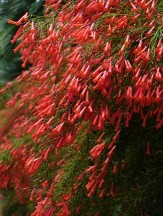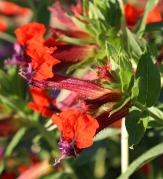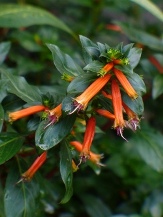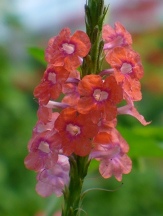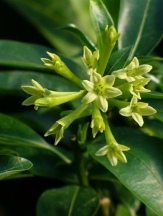Enjoying Epiphyllums – including Night Blooming Cereus and Hybrid Orchid Cacti

Epiphyllum 'Fifty Grand'
.jpg)
Night Blooming Cereus, Epiphyllum oxypetalum
Epiphyllums are one of the few true jungle cacti and are actually naturally epiphytic, meaning that they actually grow on trees or other plants, and find soil and nutrients trapped in small pockets where the branches “Y” out from trees. This means that you do not want to “over pot” your Epiphyllum and it should remain somewhat root bound and should not be kept overly moist. Allow the soil to become semi dry between waterings although they can be kept slightly more moist during the growing season (spring to late summer as a general rule) and should be kept slightly dryer when not in active growth (late fall and winter).
The Night Blooming Cereus and its hybrids, the Orchid Cacti, prefer sharply draining, acidic soils. You can use orchid bark (made of sterilized redwood bark) at a ratio of 1 part bark to 2 parts high quality cactus mix or you can create a cactus mix by adding a 1:1 ratio of small to medium gravel, large perlite, or pumice to a high quality acidic potting soil and add bark to that to create an epiphytic mix for your Epiphyllums. We generally enjoy our Epiphyllums in hanging baskets, without saucers, as this brings the large showy flowers to eye level where their beauty and/or fragrance can be easily enjoyed from the long arching leaf-like stems (a.k.a. cladodes). There are several other recipes out there and some work better for some people than others. The San Diego Epiphyllum Society has an in-depth article on Epi Soils by Roger Chapin.
.jpg)
Epiphyllum 'Thousand Pinks'
Epiphyllums, Night Blooming Cereus, and Orchid Cacti are naturally understory plants in tropical South American jungles. In other words, these plants also do not want a lot of hot direct sunlight, even through a west or south window, as they may sunburn. High indirect sunlight is preferred although they can tolerate cool early morning and some filtered sunlight (an east facing window) and very late cool evening sunlight. If light conditions are too high the foliage like stems may begin to yellow or if they sunburn they will actually turn brown and die. During the warmer parts of the growing season they can be placed on well shaded porches, patios, and hung about under the shade of trees to grow for the warm spring and summer months depending on the climate. Again these plants are from tropical climates and prefer daytime temperatures between 70-90oF and nighttime temperatures between 55oF-70oF as a general rule, although they can tolerate nighttime temperatures down to near freezing for very short periods and daytime temperatures over 100oF without any issues.
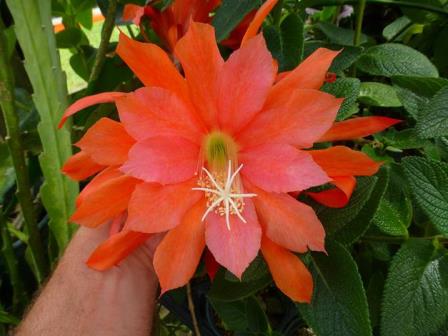
Epiphyllum 'Pumpkin'
Spring and summer are the normal flowering seasons for most of these beauties and so we should fertilize them in late winter/early spring using a non-burning, slow release fertilizer. We prefer Osmocote 14-14-14 and you can use it a rate of about 1 tablespoon per gallon of soil mix to good effect. We also liquid feed our Epiphyllums with 20-20-20 about every 6-8 weeks during the growing season.
Night Blooming Cereus and Orchid Cacti tend to flower best when they are rootbound. Periodic uppotting or repotting will be required to maintain healthy growth but is best done stepwise, meaning uppot to the next natural container size from 2">4">6">8">10". Once you reach the size that you want to maintain the plant in, typically an 8-10", you can repot the plant every 2-3 years once the potting soil has degraded. You can gently remove most of the existing soil and replace it with a new high quality mix. Pumice and medium to large redwood bark, a.k.a. orchid bark, can help to extend the life of the soil.
Additional suggestions for getting the Orchid Cacti to flower include inducing a 'rest period' in late winter by controlling moisture, temperature and light for a minimum of 3-4 and up to 8-10 weeks. Place the plants in an unheated area that remains above about 40oF and preferably drops down to about 50-55oF. They will still need to receive similar light levels to where they have been growing. They should not receive any artificial light after sunset and before sunrise during this period. At the same time, keep the plants moderately dry, not to the point of extreme wilt but significantly drier than during the growing season. At the end of the rest period or as soon as you notice buds developing, move the plants back into their normal growing area and return them to their normal watering and feeding schedule.
To see our entire collection of Epiphyllums see our "Epiphyllum" category or click here
Additional Resources for Growing Epiphyllums
San Diego Epiphyllum Society: https://sdepis.org/
Epiphyllum Society of America: https://www.epiphyllums.org/
Orchid Cactus, Epiphyllums - Oregon State University Extension Service: https://extension.oregonstate.edu/gardening/flowers-shrubs-trees/orchid-cactus-epiphyllums
Please feel free to contact us if you have any additional questions, comments, or other input.
Thank You & Good Growing,
Jeff McMillian
& the Crew at Almost Eden
![]()

